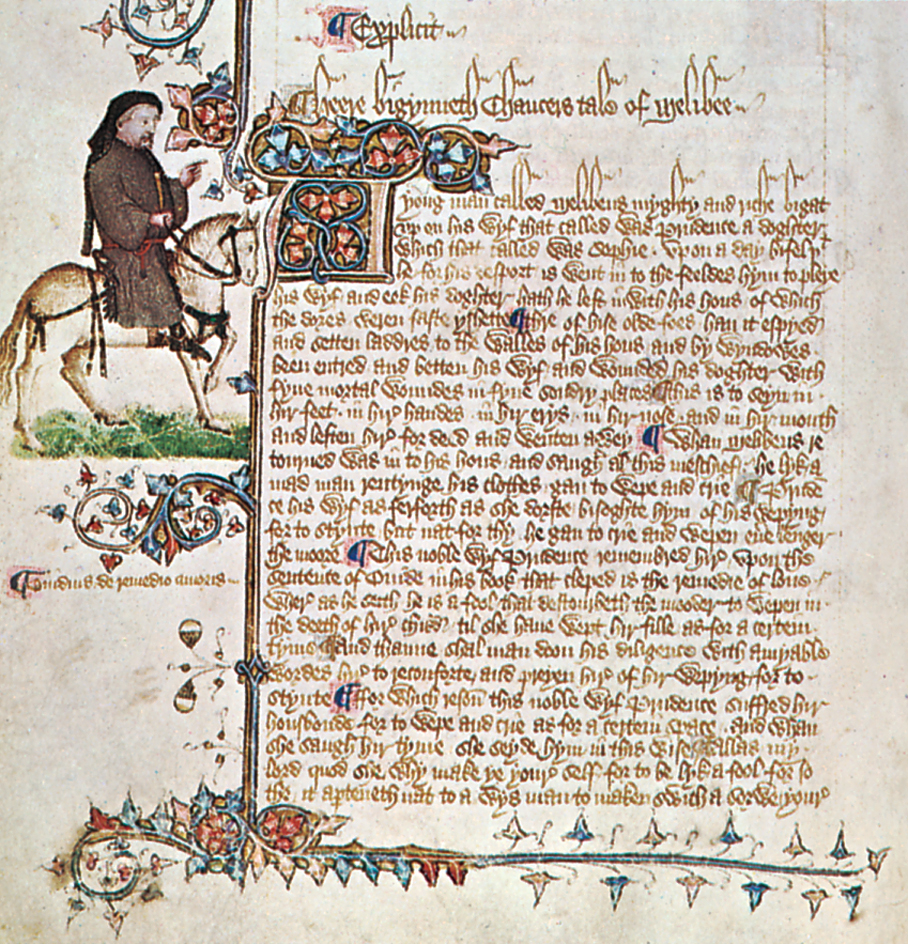Chaucer, Geoffrey, << CHAW suhr, JEHF rih >> (1340?-1400), was the greatest English poet of the Middle Ages. He wrote The Canterbury Tales, a group of stories that ranks among the masterpieces of literature.

Life.
Chaucer was born in London sometime between 1340 and 1343. He lived most of his life there. He came from a prosperous middle-class family and was trained as a civil servant and diplomat. Chaucer was controller of customs from 1374 to 1386 and clerk of the King’s Works from 1389 to 1391. He was appointed a justice of the peace in 1385 and to Parliament in 1386. His experiences in all these positions probably developed his fascination with people, his wide knowledge of English life, and the tone of charitable irony in his works.
Chaucer wrote for people in and around the courts of Edward III and, especially, Richard II. Though Chaucer supported Richard II, he also was associated with Richard’s rival, the powerful nobleman John of Gaunt. Chaucer viewed the aristocratic fashion called “courtly love” with polite and amused skepticism. In his poetry, he often satirized the fashion’s lofty ideals, elaborate etiquette, and literary style. He viewed the corruption he saw in the medieval church with less tolerance than he had for the fashion of courtly love. In The Canterbury Tales, he satirized church abuses in his portrayals of the friar, monk, pardoner, and summoner.
Chaucer was one of the most learned men of his age. He traveled in Flanders, France, Italy, and Spain on diplomatic missions. He was influenced first by French writers and then by Italian writers, especially Boccaccio, Dante, and Petrarch. Chaucer may have studied law. He was familiar with the Latin classics, medieval science, and theology. His prose works include a translation of Boethius’ Consolation of Philosophy and an essay on the astrolabe, an astronomical instrument that was the forerunner of the sextant. Chaucer died on Oct. 25, 1400.
Poetry.
Chaucer wrote in Middle English, the form of English used from about 1100 to about 1485. He was the first English poet to use heroic verse (rhymed couplets in iambic pentameter).
The Book of the Duchess (1368), one of Chaucer’s earliest works, is a graceful elegy on the death of John of Gaunt’s first wife. Chaucer modeled it on the French dream-vision form of poetry. He gradually developed his individual style in The House of Fame (1379?), The Parliament of Fowls (1380?), The Legend of Good Women (1387?-1394?), and other shorter lyrics.
Apart from The Canterbury Tales, Chaucer’s greatest poem is Troilus and Criseyde (about 1386). Adapted from a love story by Boccaccio, this poem is both a medieval romance and a philosophical tragedy. Set in ancient Troy just before its fall, it tells of the love of Prince Troilus for Criseyde. In the poem, Chaucer explored the beauty of love, the mysterious workings of fortune, and the sad brevity of earthly joy.
The Canterbury Tales (about 1386-1400) is a collection of stories told by a group of pilgrims on a journey to the shrine of Thomas Becket in Canterbury. One of the pilgrims represents Chaucer himself. Chaucer pictured this pilgrim as a simple fellow who takes everything at face value. This device allowed Chaucer to describe the other pilgrims objectively, while allowing the reader to see the pilgrims’ real personalities. For more information, see Canterbury Tales.
